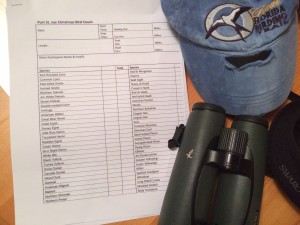 I wish I could juggle a camera with a good close-up lens along with my binoculars, spotting scope, bird book and lists, so I could share with you the beautiful beings I was amongst, these last two days. But I’m not that good. Instead I’ll paint you a picture with my words.
I wish I could juggle a camera with a good close-up lens along with my binoculars, spotting scope, bird book and lists, so I could share with you the beautiful beings I was amongst, these last two days. But I’m not that good. Instead I’ll paint you a picture with my words.
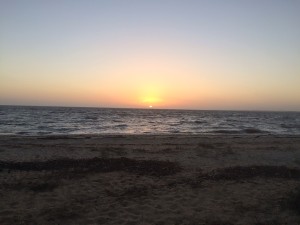
West Pass
Imagine standing on the lip of Tahiti Beach, with the West Pass, a warm gale and the rising sun at your back, and miles of salt marsh spread to the sky. That’s where I was on Monday for the 116th year of the Christmas Bird Count. These international counts show how and where bird populations come and go, and more than 72,000 citizen scientists take part.
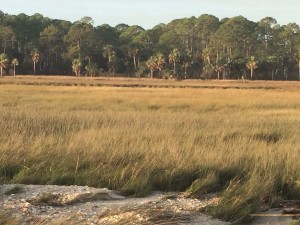
Where marsh sparrows live. Tahiti Beach, St. Vincent Island, 12/27/2015
I scuffed through the short grasses with my boots, hoping to herd sparrows toward the other birders in my party. Three different species of marsh sparrows piled up like Christmas tree ornaments in one small, skeletal shrub, long enough to clearly be identified.

What Sibley says about marsh sparrows! A lot!
Using our bird apps and field guides, we compared size and shape, nape and crown color, breast-belly contrast, and various streakings and stripings.
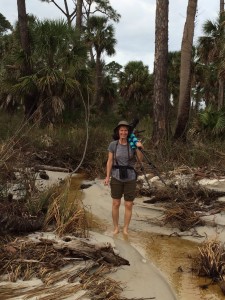
Debbie Segal, serious student of wild birds
With my intrepid birding companion Debbie Segal, I had studied hard for the sparrows, pre-count. Imagine the joy, then, of a circumstance where you could easily distinguish a seaside, from a Nelson’s, from a saltmarsh sparrow.
Heaven.
Down at Sheepshead Bayou, I trained my binoculars on a group of white wading birds standing at the water’s edge. I needed to make sure they were all snowy egrets before I added them to the day’s growing list.
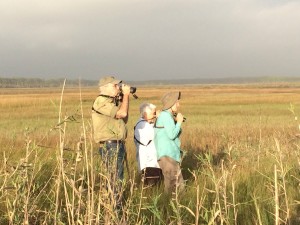
St. Vincent NWR, 2015 CBC, with Debbie Segal, Donna Gaudet and Grayal Farr
My other team members had their backs turned—they tallied bufflehead ducks, horned grebes and common loons in the lagoon, and entirely missed the miracle that happened next. Magnified in my binoculars’ field of view, I saw a full-grown, soaking wet otter emerge from the salt water and shoulder a path through the gathered egrets (9 snowy, 1 common). For all the world, it was as if the otter said: “Make way, make way. I’ve important business over in the marsh!” The egrets kerfluffled their wings, and stepped out of the mammal’s path. It humped briskly over the white sand and dropped into the juncus marsh, out of sight.
I admit I let out a little scream of excitement. I love this world so much.
************
We had begun our first full day of counting birds the day before at Cape San Blas, with a different kind of outcry. The first thing you do on the Christmas Bird Count is listen for owls in likely habitat in your assigned territory, while also searching for the glinting red eyes of whip-poor-wills on the ground.
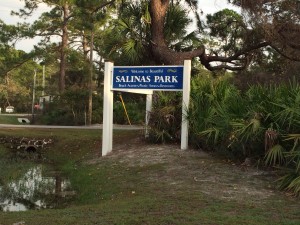
Salinas Park, Gulf County
The best owling in my count circle is among the huge old pines that grow in Gulf County’s shady Salinas Park, near the junction of 30-A. I swung my car into the park entrance an hour before dawn. Instead of mature pines and owls, my headlights flared over bare sand.
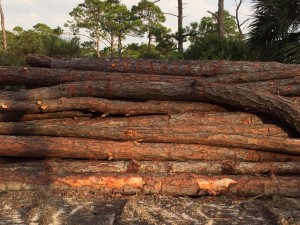
What was needlessly lost
Someone had cut dozens and dozens of the trees. Their bodies were stacked in the parking lot, branches strewn on the ground. Their stumps oozed sap, like blood.
Damn, damn, damn. No place left to for owls to roost, or bluebirds, or nuthatches, or the beautiful yellow-throated warbler.
The last year or so, Gulf County has exploded in ruthless development, lot after lot after lot cleared and filled on 30-A, the Cape, and Indian Pass. The saw palmettos and native shrubs that filter pollutants from Indian Lagoon are replaced with illegal fill, trailers and septic tanks that will eventually drain into, and contaminate, the beautiful Gulf waters.

Better now??? Not for the birds, or the trees, or ultimately, us.
Moreover, the county has been inviting development by widening the roads and scalping the cabbage palms and yaupon holly from the roadsides, so prospective investors will think…what?….south Florida? A local friend called Gulf County yesterday to investigate the tree cutting in Salinas Park. The parks director told her that the area destroyed was low-lying, buggy and “unusable in its present condition.” His goal, he told her, was make the residents proud of their park, and that it would be “gorgeous” when the “renovations” were complete.
I thought it was already so beautiful—and you and I know it was necessary–in its natural state. So do the owls and the other 89 species of wild birds we tallied on that territory during the Christmas Bird Count.
Friends, please, let us all find ways to speak powerfully for the nonhuman world in the coming year. Parks and refuges, under any jurisdiction, aren’t guaranteed protection. How badly our voices are needed!
Share On:
Sue,
Thank you for your words, beautiful and sobering.
It’s as if too many “developers and business oriented forces are playing with our planet in a game of chicken. Science, tipping points and facts don’t seem to matter as long as they think they can jerk the wheel at the very last second. That strategy didn’t always end happily.
Yours was both an inspiration and a heart-breaking story of your count. Thanks for keeping us informed with your wonderful word pictures.
Susan,
Your last paragraph says it well.
John
It’s true, Howard, and yet we keep on speaking out, don’t we. Because we are the voice of the Earth.
Thank you, Elizabeth, I wish there were only beautiful things to report. I so appreciate your support…
Thank you, John. You have always done so much for our beautiful Florida.
Hi Sue, Are we meeting tomorrow? 11 a.m.? My house or yours? Love, MJ
My heart soared and then broke as I read your essay. Wise words, all.
Carole, I pretty much hate that this is how life on Earth is right now, and that we have to face it and try to stem the damage. I’m sorry. I thank you for sticking with this journey.
Susan,
Thank you for your truth-telling.
I look forward tonyour next post.
So very happy our paths have crossed!
All best,
Beverly Frick
Back atcha, Beverly! Let’s make a point of seeing one another…..
Like Carole above, “my heart soared then broke as I read your essay.” Thank you, Susan,for sharing your experiences and your heart.